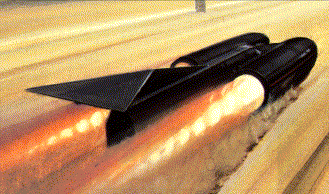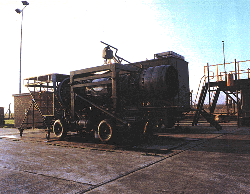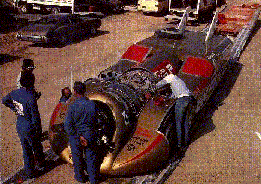 The heart of any record-breaker is the engine, or in the case of Thrust SSC, the engines. In common with
most of its predecessors, it will draw on huge amounts of power generated by powerplants designed
initially for aviation use. Every now and again somebody attempts to take the LSR by designing a
purpose built engine, or a super-lightweight car with relatively low power, but these projects are few
and far between. If you want to get serious about record-breaking, your car has to be powered by a big,
powerful ex-miltary jet - But which one?
The heart of any record-breaker is the engine, or in the case of Thrust SSC, the engines. In common with
most of its predecessors, it will draw on huge amounts of power generated by powerplants designed
initially for aviation use. Every now and again somebody attempts to take the LSR by designing a
purpose built engine, or a super-lightweight car with relatively low power, but these projects are few
and far between. If you want to get serious about record-breaking, your car has to be powered by a big,
powerful ex-miltary jet - But which one?
A bodged attempt by British European Airways (BEA) to get De Havilland to build a three engined civil airliner in the late 'Fifties to compete with the French Sud-Aviation Caravelle is hardly the kind of inauspicious event that you would readily associate with the Spey powerplants that will be used in Thrust SSC but indirectly, the company who, along with BOAC, were the founders of British Airways, were responsible for doing exactly that.
Specification DH121 called for a short haul aircraft with three engines grouped in the tail, and in which just over a hundred passengers could be transported for a range of 2,000 miles. The engine selected was the Rolls-Royce RB141, later christened the Medway. Designed by a team led by AA Griffiths and owing very little to earlier designs, the Medway gave 13,790lbs of thrust in its initial form, with predictions of up to 30,000lb in full afterburn format. Working in conjunction with American engine builders Allison, an afterburning Medway was soon showing impressive results and was interesting civil and military purchasers alike - except, that is, in the UK, where the goverment of the day had decreed piloted military attack aircraft to be obsolete and placed all its faith, misplaced as it turned out, in missile programmes.
 Just when things were looking promising, BEA suddenly changed the specification decreeing a smaller payload
and shorter range. No doubt mightily miffed by this strange behaviour, Rolls-Royce scrapped their Medway
programme - having funded five complete engines of their own - before reutilising many of the components on
what was effectively a slimmed down version of this highly promising design. As it turned out, this proved to be
a blessing in disguise because the resulting RB163, or Spey, proved to be exactly what was needed for a whole
range of military and civil aircraft. BEA did get their airliner, the Trident, but quickly realised that they should
have stuck to their original specification when the rival Boeing 727 cleaned up the market. 20/20 hindsight is a
wonderful thing!
Just when things were looking promising, BEA suddenly changed the specification decreeing a smaller payload
and shorter range. No doubt mightily miffed by this strange behaviour, Rolls-Royce scrapped their Medway
programme - having funded five complete engines of their own - before reutilising many of the components on
what was effectively a slimmed down version of this highly promising design. As it turned out, this proved to be
a blessing in disguise because the resulting RB163, or Spey, proved to be exactly what was needed for a whole
range of military and civil aircraft. BEA did get their airliner, the Trident, but quickly realised that they should
have stuck to their original specification when the rival Boeing 727 cleaned up the market. 20/20 hindsight is a
wonderful thing!
Meanwhile, the Spey began carving a niche for itself in the aircraft industry by being fitted to everything from the McDonnell Douglas Phantoms used by the Royal Navy and RAF, through to the BAC 111 medium haul jet, Vought A-7's used on US carriers, Gulfstreams, Nimrods and even the Chinese B-7 all-weather attack fighter. Beyond that, it was also used on the ground for power generation and as the main motive power for Royal Navy warships. Quite an engine - but how come it was so successful? To understand that, and the reasons why it was chosen for Thrust SSC, a quick trip through jet-engine history is required.
In its simplest form, a jet engine is a pipe through which air is forced and into which fuel is pumped along with a spark to make the whole thing go bang! The resulting hot air expands rapidly and squirts out of the back end pushing the jet - and the aircraft to which it is attached - forwards. A cone shaped pipe and forward motion makes sure that the fresh supply of air entering the front of this simple jet is compressed enough to continue this controlled explosion, and it was exactly this type of cheap and cheerful ram-jet that powered the notorious V-1 'doodlebug' so successfully during WWII. The trouble with simple ram-jets is that they need forward motion to continue gulping air and there is no throttling control to adjust the power - it's all or nothing!
A handful of people, but most notably Frank Whittle in the UK, solved this problem by fitting a centrifugal compressor ahead of the jet pipe. Looking somewhat like a beefier version of the paddle seen in a top-loading washing machine, this impeller spun around forcing air into a series of combustion chambers surrounding the core of the engine, where fuel was injected and the whole explosive charge made to go bang by sparking plugs. The hot air rushed out into the jet-pipe in which was installed a multi-bladed turbine wheel mounted on a central shaft. The hot air turned the turbine and was in turn ejected out of the back of the jet pipe providing thrust. But, the turbine blades also drove the shaft connected to the centrifugal compressor which compressed the air in the first place - brilliant!
If he'd only known it at the time, A A Griffiths who was then working at the Air Ministry Laboratory already held the key to the next stage of jet-engine development, but so wrapped up was he in his own technically sound but horrendously complex designs, that not only did he pour scorn on Whittle's ideas, but he also failed to see how his own could have improved the basic turbo-jet concept.
Griffiths had been working on axial flow turbines in which the place of Whittle's centrifugal impeller had been taken by a whole series of blades mounted longitudinally on a central shaft. The blades were of varying sizes so that air sucked in at the front was compressed in stages as it passed along the length of the engine. Again the compressed air was forced into combustion chambers, the resulting hot air driving high pressure turbine blades. The crucial difference was that in the Griffiths designs, the turbine not only drove the axial compressor but also a convential propellor. Very little thought at all was given to the possibilities of pure jet thrust. But others did, including Whittle himself, and before long the multi-stage axial compressor had soon replaced the centrifugal compressor, while at the back end, the simple single stage turbine had also been replaced by multi-stage affairs. What this did of course, was to greatly increase the power output by forcing more air through the engine in order to burn fuel at a faster rate. Before long, the axial jet had replaced the simple centrifugal turbojet as the preferred powerplant for performance aircraft.
The next major advance came when it was realised that not all the compressed air needed to be passed through the combustion chamber. In fact, if some of the 'fanned' air was extracted and passed through an annular duct surrounding the hot core of the engine, this 'bypassed' air could be blasted out of the back providing thrust just like the hot air. So in effect, the hot turbine was producing its own thrust and driving a large fan at the front which acted a bit like a ducted propellor. The engineering advantages were cooler running temperatures, and much greater thrust with less noise for the same fuel consumption. Soon, Bypass turbofans were de rigeur with performance being related to the bypass ratio acheived - that is the amount of air bypassed compared to the amount of air passed through the combustion chambers.
The final piece of the jigsaw puzzle emerged when it was realised that at high flow rates, some unburnt and partially burnt fuel, plus a lot of air was flowing out of the hot end so, by extending the tailpipe and putting a spark in it, this mixture could be augmented by a separate fuel supply and produce additional thrust by the process of 'afterburning'. Bung one of those on the back end of a big, meaty bypass turbofan and you have something that will blow down trees and empty your friendly local petrol station of fuel in no time at all! All of which, brings us right back to the Spey 205s that will be fitted to Thrust SSC.
 The trusty Rolls-Royce Avon used in Thrust2 was a turbojet, rather than a turbofan and clearly not powerful
enough to get the job done this time, so contacts in the aircraft industry and the RAF were canvassed for their
views. The criteria were: availability, affordability, sufficient power, ruggedness and reliability. Like McLaren
with their rival project, initial thoughts centred on the RB199 as used in the Tornado. It's an impressive engine
that compared to the Spey is smaller, lighter and more sophisticated while giving roughly the same power. As an
example, the standard Spey 202 has a thrust to weight ratio of 5 compared to 7 for the RB199. But closer
checks against the criteria mentioned revealed some potential problems. For a start, the electro-mechanical
controls are all computer driven which would necessitate complex and expensive re-programming for ground
level operations - no problem for McLaren with their F1 experience but just one more potential problem waiting
to happen for those with less experience while running on a desert thousands of miles from home. Being smaller,
the RB199 is also engineered to very close tolerances, including finely drilled cooling ducts running within the
turbine blades. What would happen if the engine ingested dust from the desert surface and blocked those
cooling passages. Maybe it wouldn't be a problem, but then again.....?
The trusty Rolls-Royce Avon used in Thrust2 was a turbojet, rather than a turbofan and clearly not powerful
enough to get the job done this time, so contacts in the aircraft industry and the RAF were canvassed for their
views. The criteria were: availability, affordability, sufficient power, ruggedness and reliability. Like McLaren
with their rival project, initial thoughts centred on the RB199 as used in the Tornado. It's an impressive engine
that compared to the Spey is smaller, lighter and more sophisticated while giving roughly the same power. As an
example, the standard Spey 202 has a thrust to weight ratio of 5 compared to 7 for the RB199. But closer
checks against the criteria mentioned revealed some potential problems. For a start, the electro-mechanical
controls are all computer driven which would necessitate complex and expensive re-programming for ground
level operations - no problem for McLaren with their F1 experience but just one more potential problem waiting
to happen for those with less experience while running on a desert thousands of miles from home. Being smaller,
the RB199 is also engineered to very close tolerances, including finely drilled cooling ducts running within the
turbine blades. What would happen if the engine ingested dust from the desert surface and blocked those
cooling passages. Maybe it wouldn't be a problem, but then again.....?
And then somebody suggested the Spey. 'Oh God! - not the Spey!' was Richard Noble's immediate response, but things got better when it was pointed out that a final development of the afterburning, bypass turbofan Spey fitted to Phantoms had been developed with crystal turbine blades that allowed either greater power or longer life - guess which one the Thrust SSC team were interested in? Although the programme did not go into production, fortuitously some of the people who'd worked on it were still around. Not only that, but they also knew the whereabouts of two of only twelve engines to be built in this format and since the need for them had long since gone away, Thrust SSC soon found itself the proud owner of two 25,00lbs thrust Spey 205 engines still in Rolls-Royce wrappings, plus a couple of 202's for shakedown runs and systems checks.
Want to know how Thrust's engines work? This fabulous animated engine, which can be downloaded by clicking here, explains all. If you have any trouble downloading the file with your browser try holding shift while you click.
The file (install.exe) is a 176K self extracting file which will create a readme file and the program itself (sscspey.exe) which can then be run.
 |
 |
 |
||
| Sponsored by | This site best viewed with Microsoft Internet Explorer 3 | |||